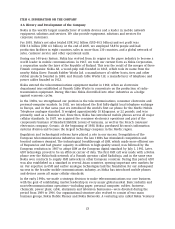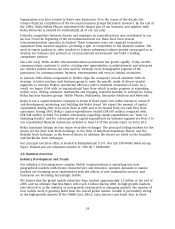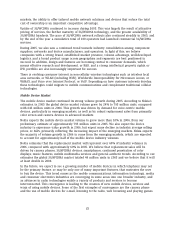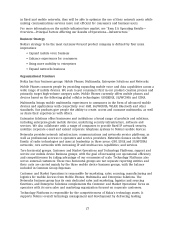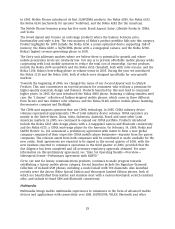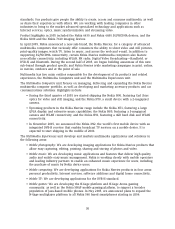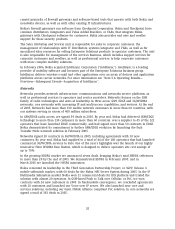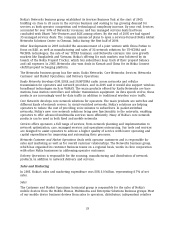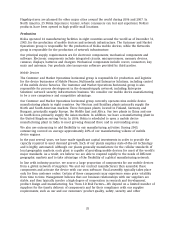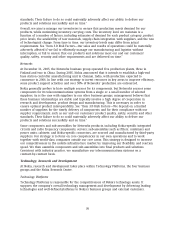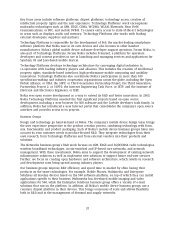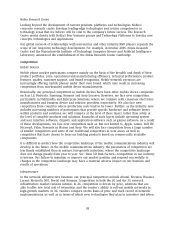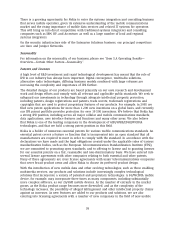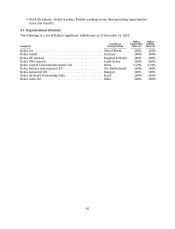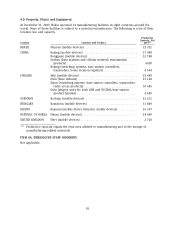Nokia 2005 Annual Report Download - page 35
Download and view the complete annual report
Please find page 35 of the 2005 Nokia annual report below. You can navigate through the pages in the report by either clicking on the pages listed below, or by using the keyword search tool below to find specific information within the annual report.Nokia’s Networks business group established its Services Business Unit at the start of 2005,
building on close to 20 years in the services business and seeking to tap growing demand for
services as both operator competition and technological complexity increase. By year end, Services
accounted for over 30% of Networks’ revenues, and key managed services deals had been
concluded with Bharti Tele-Ventures and 3GIS among others. By the end of 2005 we had signed
35 managed services deals. The company announced plans to open a services-focused Nokia Global
Networks Solutions Center in Chennai, India during the first half of 2006.
Other developments in 2005 included the announcement of a joint venture with China Putian to
focus on R&D, as well as manufacturing and sales of 3G network solutions for TD-SCDMA and
WCDMA technologies; the sale of our TETRA business; and Networks entrance into new growth
markets like Bangladesh and Vietnam. Nokia’s offering for such markets was bolstered by its
launch of the Nokia Prepaid Tracker, which lets subscribers keep track of their prepaid balance
and call expenses. In 2005, Networks also won deals in Kuwait and China for its Nokia Connect
eRefill prepaid recharging platform.
The Networks business group has five units: Radio Networks; Core Networks; Services; Networks
Customer and Market Operations; and Delivery Operations.
Radio Networks develops GSM, EDGE and 3G/WCDMA radio access networks and cellular
transmission for operators and network providers, and in 2005 said it would also support wireless
broadband technologies such as WiMAX. The main products offered by Radio Networks are base
stations, base station controllers and cellular transmission equipment. As data speeds evolve, these
products are increasingly used for data traffic in addition to traditional wireless voice traffic.
Core Networks develops core network solutions for operators. The main products are switches and
different kinds of network servers. In circuit-switched networks, Nokia’s solutions are helping
operators to reduce the cost of providing voice minutes to subscribers. In packet-switched
networks, Nokia’s new core network solutions bring new functionality to the networks, enabling
operators to offer advanced multimedia services more efficiently. Many of Nokia’s core network
products can be used in both fixed and mobile networks.
Services offers operators a full range of services, from network planning and implementation to
network optimization, care, managed services and operations outsourcing. Our tools and services
are designed to assist operators to achieve a higher quality of service with lower operating and
capital expenditures by improving and automating their processes.
Networks Customer and Market Operations deals with operator customers and is responsible for
sales and marketing as well as for overall customer relationships. The Networks business group,
which has organized its customer business teams on a regional basis, works in close cooperation
with other Nokia businesses in addressing operator customers.
Delivery Operations is responsible for the sourcing, manufacturing and distribution of network
products, in addition to network delivery and services.
Sales and Marketing
In 2005, Nokia’s sales and marketing expenditure was EUR 3.0 billion, representing 8.7% of net
sales.
Sales
The Customer and Market Operations horizontal group is responsible for the sales of Nokia’s
mobile devices from the Mobile Phones, Multimedia and Enterprise Solutions business groups. Most
of our mobile device business derives from sales to operators, distributors, independent retailers
33


